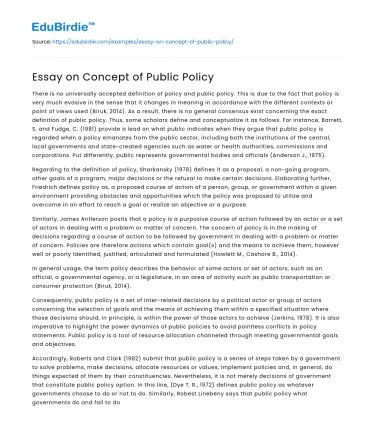There is no universally accepted definition of policy and public policy. This is due to the fact that policy is very much evasive in the sense that it changes in meaning in accordance with the different contexts or point of views used (Biruk, 2014). As a result, there is no general consensus exist concerning the exact definition of public policy. Thus, some scholars define and conceptualize it as follows. For instance, Barrett, S. and Fudge, C. (1981) provide a lead on what public indicates when they argue that public policy is regarded when a policy emanates from the public sector, including both the institutions of the central, local governments and state-created agencies such as water or health authorities, commissions and corporations. Put differently, public represents governmental bodies and officials (Anderson J., 1975).
Regarding to the definition of policy, Sharkansky (1978) defines it as a proposal, a non-going program, other goals of a program, major decisions or the refusal to make certain decisions. Elaborating further, Friedrich defines policy as, a proposed course of action of a person, group, or government within a given environment providing obstacles and opportunities which the policy was proposed to utilize and overcome in an effort to reach a goal or realize an objective or a purpose.
Save your time!
We can take care of your essay
- Proper editing and formatting
- Free revision, title page, and bibliography
- Flexible prices and money-back guarantee
Similarly, James Antlerson posits that a policy is a purposive course of action followed by an actor or a set of actors in dealing with a problem or matter of concern. The concern of policy is in the making of decisions regarding a course of action to be followed by government in dealing with a problem or matter of concern. Policies are therefore actions which contain goal(s) and the means to achieve them, however well or poorly identified, justified, articulated and formulated (Howlett M., Cashore B., 2014).
In general usage, the term policy describes the behavior of some actors or set of actors, such as an official, a governmental agency, or a legislature, in an area of activity such as public transportation or consumer protection (Biruk, 2014).
Consequently, public policy is a set of inter-related decisions by a political actor or group of actors concerning the selection of goals and the means of achieving them within a specified situation where those decisions should, in principle, is within the power of those actors to achieve (Jerkins, 1978). It is also imperative to highlight the power dynamics of public policies to avoid pointless conflicts in policy statements. Public policy is a tool of resource allocation channeled through meeting governmental goals and objectives.
Accordingly, Roberts and Clark (1982) submit that public policy is a series of steps taken by a government to solve problems, make decisions, allocate resources or values, implement policies and, in general, do things expected of them by their constituencies. Nevertheless, it is not merely decisions of government that constitute public policy option. In this line, (Dye T. R., 1972) defines public policy as whatever governments choose to do or not to do. Similarly, Robest Linebeny says that public policy what governments do and fail to do for their citizens. Here it also important to consider in mind that inaction is also an action; thus, failure to make decisions is a public policy in itself since the resultant effect of government's inaction or refusal to make certain decisions is felt by the public. Alternative precarious point is that whatever governments choose to do or not to do should not be borne out of a critical analysis of the issues in relation to the objectives and goals of government.
Very recently, Anyebe (2018) broadly conceptualized public policy as what government intends to do to achieve certain goals. This definition makes public policy look like a mere decision of government. In other words, that is to say that the only declaration of principles, wishes, intentions, or expression of desires cannot be called public policy. Public policy should mean actual resource allocation presented by projects and programs designed to respond to perceived public problems and challenges requiring government action for their solution. That is, it should mean hard patterns of resource allocation presented by projects and programs designed to respond to perceived public demands. Public policy, therefore, is that policy developed and implemented by government agency and officials, though non-state actors and factors may influence its process.
Thus, public policy is what the government chooses to do, or not to do. In other words, it is a decision made by government to either act, or not acts in order to resolve a problem. It is also a course of action that guides a range of related actions in a given field.






 Stuck on your essay?
Stuck on your essay?

